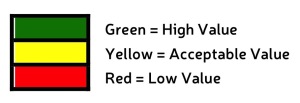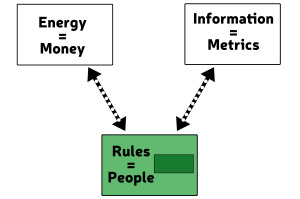PEOPLE FOLLOW RULES OF BEHAVIOR
We’ve talked about energy (money) and information (metrics), but there’s still one piece of the energy and information system to cover, and that’s rules.
Rules, of course, are principles or regulations that govern action. In an energy and information system, the rules connect energy and information in a feedback loop. The rules determine the information that will result from energy. And the information, subject to the rules, will impact the energy in return. Thanks to the rules, changing any part of the system affects every other part of the system in a consistent way.
As I see it, people— or more specifically, people’s behaviors—act as the rules in your business engine. The rules show you why things are happening, who things are happening to, where the work is happening, and when the work is happening.
People are what link the money and metrics. The money that you put into your people (i.e. how much you pay them) impacts their behavior, which in turn, influences the quality of their work (e.g. how well they perform). But it goes the other way too. When people work to modify their metrics, they are acting in a way that affects the amount of money that they are bringing into or taking out of the system. The same is true when it comes to the materials, goods, or services your employees purchase for their jobs. Their spending decisions impact quality. Any change they make to the quality of materials, goods, or services will likely have repercussions for costs.
Let’s go back to our car metaphor one more time.
You have a car. The energy is the gas, the information is the miles, the rules are the miles per gallon. Ultimately, you are going to determine how many miles per gallon your car gets based on how quickly you accelerate.
What we’re really talking about both in terms of the car and your business engine is the relationship between cost and quality—which is another way of saying value. What we want is the highest value. The best quality at the lowest cost. The people are what establish that value. In an ideal business engine, everyone is working to increase the value of their work.
When we modeled money, we asked “how much” and looked for places where we were losing money. In our metrics model the focus was “how well”. This model allowed us to see where there was friction in the system. In our people model, what we want to see is “how valuable” the work of our employees is. We’ll do this by assessing cost versus quality for each job function or each employee task. Then we’ll look for places where value is low.
For this model, we will be using rectangles to represent people; value will be indicated by color. At this point, you can probably predict the color-coding scheme:

Once you’re able to identify where value is low in your business engine, you can attempt to increase it. You do that by changing the behavior of your people. And the way you do that is by experimenting with the money or the metrics in your system. Because you are dealing with a feedback loop, tweaking the money will change the behavior will impact the metrics. Likewise, tweaking the metrics will change the behavior will impact the money.
- Rules are principles or regulations that govern action. In an energy and information system, the rules connect energy and information in a feedback loop.
- Because of rules, changing any part of the system affects every other part of the system in a consistent way.
- People’s behaviors act as rules in a business system.
- In Business Visualization, we determine the value (cost v. quality) of the work of employees and represent it in terms of green (high value), yellow (acceptable value), and red (low value) rectangles.
In the next section you will learn how to visualize the value of employee work.
